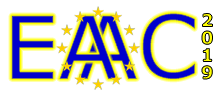Speaker
Description
During laser solid interactions, the onset of Weibel instability can generate super strong magnetic field structures (up to several kT) at the surface and within the bulk of the solid targets. Weibel magnetic fields can be used to understand several physical events in astrophysics [1], laser driven inertial confinement fusion process [2] and gamma-ray generation [3].
Here we report on the measurements of integrated Weibel magnetic fields at femtosecond time scale by using relativistic electron bunches from laser wakefield accelerators (LWFA) to probe the Weibel instability driven by the interaction between ultrashort (30 fs) intense ($I_0>10^{18}W/cm^2$) laser pulses and thin solid targets.
Experiments on hybrid Plasma Wakefield Acceleration, in which LWFA-generated electron beams are used to drive wakefield in another plasma target [4], demonstrated that the impact of such a strong magnetic field on relativistic electron bunch can cause significant beam quality degradation, which complicates its further transportation and utilisation. We will present experimental and simulation results showing few $kT⋅\mu m$ integrated B-field, generated at the surface of the solid target within a few microns depth. The results show that the Weibel instability at femtosecond time scale can be explored with a convenient and simple method based on LWFA.

